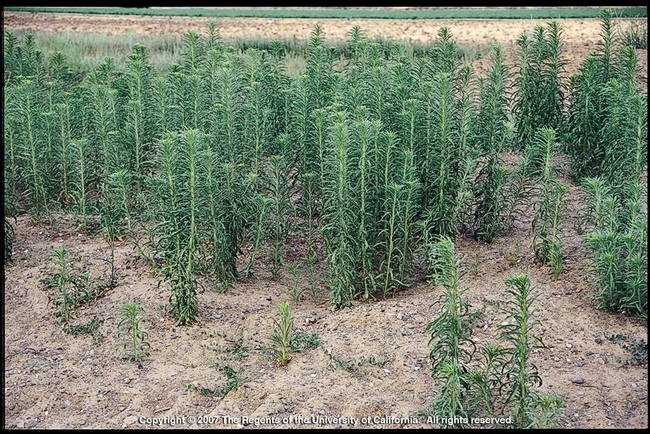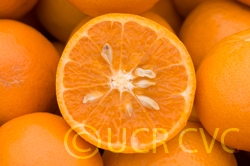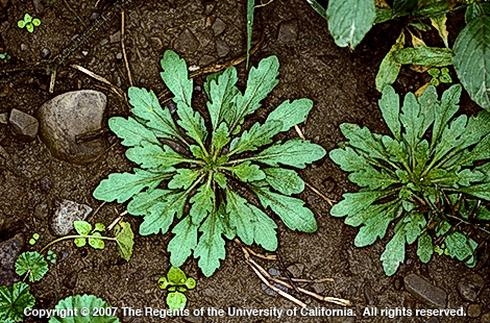- Author: Ben Faber
Researchers have now confirmed that six glyphosate-resistant weed species have been identified in California. Four have been known to exist for some time; they are horseweed (marestail, Conyza sp.), hairy fleabane, rigid ryegrass and annual ryegrass. To that list, junglerice and Palmer amaranth in the Central Valley have been recently added to the list. Additional weeds that have become more of a challenge to control and are on the suspect list are goosegrass and, in the central San Joaquin Valley, the summer grasses sprangletop and witchgrass.
There have never been a lot of herbicides registered for avocado, largely because once they are mature, they self-mulch with their leaves. It's really young orchards that have a weed problem. Growers for the most part have not used pre-emergent herbicides and relied on the many glyphosate products that originally started with Roundup. Sethoxydim (Poast) is registered for non-bearing orchards, but then what can be used as post-emergence herbicides when there is still large open spaces between trees when they are young and bearing? There are still some formulations of paraguat and diquat available for use on avocado, but horseweed is also showing resistance to these materials. Paraquat is also a restricted use material so limits who can apply it. That leaves some of the pre-emergents, such as norfluazon (Solicam), oxyfluorfen (Goal), oryzalen (Surgflan) and simazine (Pricep). These all require water to activate them, and in years with low rainfall efficacy can be erratic.
From a postemergence standpoint for glyphosate-resistant horseweed the options are pretty slim in avocado.
-
Paraquat is registered and likely to be pretty effective but has regulatory and safety baggage.
-
Diquat is registered in nonbearing orchards and likely to be effective.
-
Carfentrazone is registered but not very effective on Conyza.
Oxyfluorfen will help glyphosate performance to some extent on Conzya, but not likely to be fully satisfactory.
From a preemergence standpoint:
-
Simazine should be really effective on Conzya. It would have groundwater and runoff concerns in some areas.
-
A combination of oxyfluorfen plus pendimethalin or oryzalin would probably be the best available bet for broad spectrum PRE control with decent crop safety.
-
Isoxaben is registered on non-bearing avocado with reasonable Conzya control and good crop safety
Flumioxazin has a non-bearing label and should be pretty good on Conzya.
There has always been concern about the effect on shallow rooted avocado using pre-emergents. This has not been documented, but based on grower experience.
There have never been a lot of herbicides registered for avocado, largely because once they are mature, they self-mulch with their leaves. It's really young orchards that have a weed problem. Growers for the most part have not used pre-emergent herbicides and relied on the many glyphosate products that originally started with Roundup. Sethoxydim (Poast) is registered for non-bearing orchards, but then what can be used as post-emergence herbicides when there is still large open spaces between trees when they are young and bearing? There are still some formulations of paraguat and diquat available for use on avocado, but horseweed is also showing resistance to these materials. Paraquat is also a restricted use material so limits who can apply it. That leaves some of the pre-emergents, such as norfluazon (Solicam), oxyfluorfen (Goal), oryzalen (Surgflan) and simazine (Pricep). These all require water to activate them, and in years with low rainfall efficacy can be erratic.
We are currently working on getting registration the post-emergence herbicide glufosinate (Rely) registered for avocado. It's used extensively in other tree crops with success to control many weeds including the Conyza weeds. The registration is being sought through the IR-4 Project (Interregional Research Project Number 4) since 1963 has been the major resource for supplying pest management tools for specialty crop growers by developing research data to support new EPA tolerances and labeled product uses.
Photos of young and maturing Conyza


- Author: Cheryl Reynolds
New Pesticide Resistance Online Course with Continuing Education Units
Author: Cheryl Reynolds, UC Statewide IPM Program
An online course highlighting how pesticide resistance develops among pests is now available on the UC IPM Web site. Created primarily for pest control advisors and other licensed pesticide applicators, this course describes the mechanisms of resistance in pathogens, insects, and weeds and discusses ways to manage resistance within the different disciplines.
The online course is divided into three narrated presentations followed by a final test for each section. This course has been approved for 2 continuing education units in the “Other” category from the Department of Pesticide Regulation.
This course is based on a series of workshops held in Davis, Fresno, and at the Kearney Agricultural Research and Extension Center during the spring of 2014 presented by Dr. Doug Gubler (Dept. of Plant Pathology, UC Davis.), Dr. Larry Godfrey (Dept. of Entomology and Nematology, UC Davis), Dr. Beth Grafton-Cardwell (Lindcove Research and Extension Center and UC Riverside), and Dr. Kassim All-Khatib (UC Statewide IPM Program).
Check out the new course at http://www.ipm.ucanr.edu/training/pesticide_resistance.html.

- Author: Ben Faber
Recently, I read an article in "Fresh Plaza" about the arrival of large amounts of 'Kinnow' mandarin fruit from Pakistan. http://www.freshplaza.com/article/117470/Discover-Pakistani-kinnow-mandarins-at-Fruit-Logistica-2014#SlideFrame_1
This is a country that is surrounded by countries with huanglongbing. It's also the country where Mark Hoddle, Biocontrol Specialist from UC Riverside, collected Tamarixia radiata , the tiny wasp that is helping control Asian Citrus Psyllid. Pakistan has invested heavily in juice plants just for this industry which was established with this selection that came out of the Citrus Research Station breeding program in the 1930's. It makes me wonder if there might be a significant tolerance to this citrus disease in this mandarin variety. There has been a lot of work by both USDA and U. of Florida evaluating citrus varieties for tolerance to HLB. A wide range of tolerances have been noted. Fred Gmitter along with others are involved with this work and find that under different climatic conditions, resistance can vary. In the 'Kinnow' variety, it looks like there is hope in finding a variety that can be used to breed tolerance into other varieties. The fruit itself is noted for its juiciness and sweetness. But as you can see from the photo, it's got a lot of seeds.

- Author: Oleg Daugovish
It is not always easy to kill weeds with herbicides for several reasons, but if you apply the right material at the right time to susceptible weeds you expect control. But you should never assume it, because resistant weeds rely on this assumption.
Repeated use of herbicides with the same mode of action (usually the same target site within plant) selects for naturally occurring resistance traits in weed population. The few resistant weeds proliferate since there is no longer competition from susceptible types and if other control measures are not used.
Hairy fleabane (Conyza bonariensis) resistance to the two most commonly used herbicides – glyphosate (Roundup) and paraquat - is widely reported in California, including Ventura County. A close relative – horseweed or mare’s tail (Conyza canadensis) has wide-spread glyphosate resistance, as well.
These weeds are most frequently found at road sides, ditches and just about every site with infrequent disturbance. Of course, that is where glyphosate and paraquat are routinely applied. What’s worse, they produce thousands of wind-dispersed seeds that travel up to 3 miles and carry the herbicide resistance in them to new places. In fact these and other wind-dispersed weed species are increasingly common in our agricultural and urban areas because we fail to control them before seed production. The seed germinate on moist soil surfaces without incorporation and rapidly grow and reproduce.
There are several strategies to manage these herbicide resistant weeds that can be combined:
- Identify what species of weeds you have and select management options specific to your weeds and crop. You can look up susceptibility of weeds to herbicides for most crops at http://www.ipm.ucdavis.edu/PMG/crops-agriculture.html. These susceptibility tables are based on results of University of California research trials in those crops and are updated periodically.
- Always evaluate the efficacy of your herbicide application and look for weeds that escaped treatment. If one or two species survived treatment – they are likely resistant. If most weeds did - perhaps there was a general problem with herbicide application.
- Control weeds when they are small. Large mature weeds are more difficult to kill with herbicides but even resistant weeds can be controlled with herbicides when small. These weeds only reproduce by seed, if you see them flowering it may be already too late.
- To control escaped weeds use herbicide with a different mode of action appropriate to your crop/non-crop site.
- Use mechanical methods of weed removal – there has not been reported resistance to a cultivator or hoe
- Be a good neighbor – communicate with land-owners near you about the wind-dispersed weeds traveling between nearby properties and control them. Even if you manage weeds very well, wind dispersed species can travel to your site from surrounding areas, establish and compete at the time when neither herbicides nor labor for hand-weeding are available.
Herbicide resistance has nowadays been reported for most herbicidal modes of action. Because of its intensive, high-input cropping systems, the United States has more resistant bio-types (131) than any other country. Hopefully we’ll have fewer in Ventura County if we pay attention. California Weed Science Society has a priority focus on the issue and has more information at:
http://www.cwss.org/CWSSJournal/2013_01_CWSSResearch.pdf
Young plants of hairy fleabane (top) and Horseweed/mare’s tail (below) should be controlled before flowering.


- Author: Kurt Hembree
While both horseweed and hairy fleabane have been here since farming began in the region, it’s only since about 2003 that they have become such an obvious problem, particularly in tree and vine systems and non-crop areas.
In the past, the traditional use of combinations of pre- and postemergence herbicides and/or cultivation was adequate to manage them. However, recent changes in environmental regulations, economics, herbicide use patterns (toward more postemergence-only programs), treatment timing, and glyphosate-resistant biotypes have all contributed to the problem. Other factors contributing to their spread include, high seed production, wind dissemination, lack of seed dormancy requirement, preference for undisturbed areas (i.e. tree and vine rows), and adaptability to both moist and dry soils.
To get these weeds back under control, it is important that growers, managers of non-crop areas, and other land owners all do their part to help resolve the issue. Regardless of control tactics used, preventing new seed production is a must to be successful. It is also critical to understand what we’re dealing with when it comes to timing management efforts.
Although considered summer annuals, they have also been seen emerging in early October in the southern San Joaquin Valley (see Figure). During this time, they appear to go through an over-wintering or “survival” stage, where root growth seems more important than leaf production. So, by the time spring emergence occurs in mid-February, plants that actually emerged several months earlier may only appear to look the same as those that just emerged. This may help explain why some late-winter or early-spring applications of postemergence herbicides are not as effective.
Relying only on postemergence products can make horseweed and hairy fleabane very problematic. Consider including effective soil-residual herbicides (Table 1) where possible. Once under control, apply treatments every 2nd or 3rd year to maintain their control. Also consider making split-applications in Oct/Nov and again in Jan/Feb if you have seen them emerge during these periods in your specific area. If you farm in a groundwater protection area (GWPA), you will have to get a permit to use some of these products (refer to your county agricultural commissioner for local GWPA regulations). It is important to know, that while most of the effective materials on these weeds fall under GWPA regulations, they can still be used in many cases and should be considered.
|
Table 1. Preemergence herbicides for horseweed and hairy fleabane control in tree and vine crops in California |
|
|
Herbicide |
Notes |
|
Bromacil (Hyvar X) |
Citrus >4 years, GWPA permit needed, 3-4 lb/A in fall and winter, HW=C, HF=C |
|
Bromacil + Diuron (Krovar) |
Citrus >3 years, GWPA permit needed, 3 lb/A in fall and winter, HW=C, HF=C |
|
Diuron (Karmex, Direx, etc.) |
Established fields, GWPA permit needed, 2 lb in fall and winter, HW=P, HF=P |
|
Isoxaben (Gallery T&V) |
NB fields only, 10.6 oz/A, HW=C, HF=C does not control grasses |
|
Flumioxazin (Chateau) |
Bearing almond/pistachio/grape, NB others, 6 oz/A fall and winter, HW=C, HF=P |
|
Norflurazon (Solicam) |
Established fields, GWPA permit needed, 2.5-5 lb, adjust to soil type, HW=P, HF=P |
|
Oxyfluorfen (Goal, etc.) |
NB citrus, bearing/NB others, 6-8pt/A, HW=P, HF=P |
|
Simazine (Princep, etc.) |
Established fields, GWPA permit, 2 qt or 2 lb fall + winter, mix w/diuron, HW=C, HF=P |
|
Thiazopyr (Visor) |
Bearing/NB citrus, NB others, 4 pt/A winter or 2 pt in fall and winter, HW=P, HF=P |
|
NB = non-bearing only HW = horseweed HF = hairy fleabane C = effective control P = partial control This is not a complete list of registered products available. Check with your pesticide dealer for other products available. It is not a written recommendation for herbicide use. Always read and follow all label recommendations. |
|
Sensitivity to postemergence herbicides decreases the older horseweed and hairy fleabane get. Use higher label rates of effective materials (Table 2), proper coverage, and treat when they have
|
Table 2. Effect of glyphosate rate and timing on control |
|
|
Hairy fleabane growth stage and lb ai/A for good control |
Horseweed growth stage and lb ai/A for good control |
|
3-6 leaf = 0.5 |
5-8 leaf = 1.0 |
|
7-12 leaf = 1.0 |
11 leaf to 4” bolted = 2.0 |
|
13-19 leaf = 1.5 |
4” to 12” bolted = 4.0 |
|
20-21 leaf = 2.0 |
|
|
>25 leaf = erratic |
|
|
Prather, UC KAC 1999 and Shrestha et. al., UC KAC 2005 |
|
Table 3. Herbicides and rates for control at
|
Herbicide |
Rate/A |
|
Rely + AMS |
1 to 1.5 gal |
|
Gramoxone Inteon, etc. + NIS or COC |
2.0 |
|
Roundup Weathermax, etc. |
47 fl oz |
|
Shark EW + COC |
2 fl oz |
|
2,4-D (Dri Clean, etc.) |
1.55 lb |
|
Glyphomax, etc. + Chateau |
64 fl oz + 4 oz |
|
Read and follow label for rates and recommendations. |
|
Also consider using spray additives (citric acid, ammonium sulfate, spreaders, etc.), if allowed on the label, to improve activity. Tank-mixing various postemergence products can also work well (i.e. glyphosate at 2 lb ai/A plus 2,4-D at 1.5 lb ai/A or Chateau at 2-4 oz/A) are effective treatments. There are numerous products sold in California that contain glyphosate, but they do not all contain the same amount of active ingredient. Read the label carefully to make sure you are using the correct amount of product that will give you a rate of at least 2.0 lb ai/acre (Table 4). If you are using recommended label doses and herbicide timing and are using properly calibrated and operating spray equipment and you still have some of these weeds escaping control, contact your local farm advisor and chemical representative to make sure you do not have an herbicide-resistant biotype. If it is determined that you do, you will need to make changes to your weed management program as soon as possible to eradicate the problem.
In addition to appropriate herbicide selection and use, cultivation can also play an important role in horseweed and hairy fleabane management. Use shallow cultivation to dislodge small plants (
|
Table 4. Comparative rates of some glyphosate products |
|
|
Herbicide |
Fl oz for 2.0 lb ai/A |
|
Touchdown Hitech |
42 |
|
Roundup Weathermax |
47 |
|
Touchdown Total |
50 |
|
Roundup Original |
64 |
|
Glyphomax |
64 |
|
Touchdown |
70 |
Managing horseweed and hairy fleabane can seem like a daunting task. However, with the proper selection and use of chemical and mechanical tools, management can be possible. One thing to keep in mind when attacking these two weeds, other weed species may also be waiting for their opportunity once you have got these out of the way. So, it’s a good idea to routinely monitor your fields following each herbicide application and check for any kind of weed escape or shift in the types of weeds present.
Below: Horseweed on top and Hairy Fleabane on bottom.





